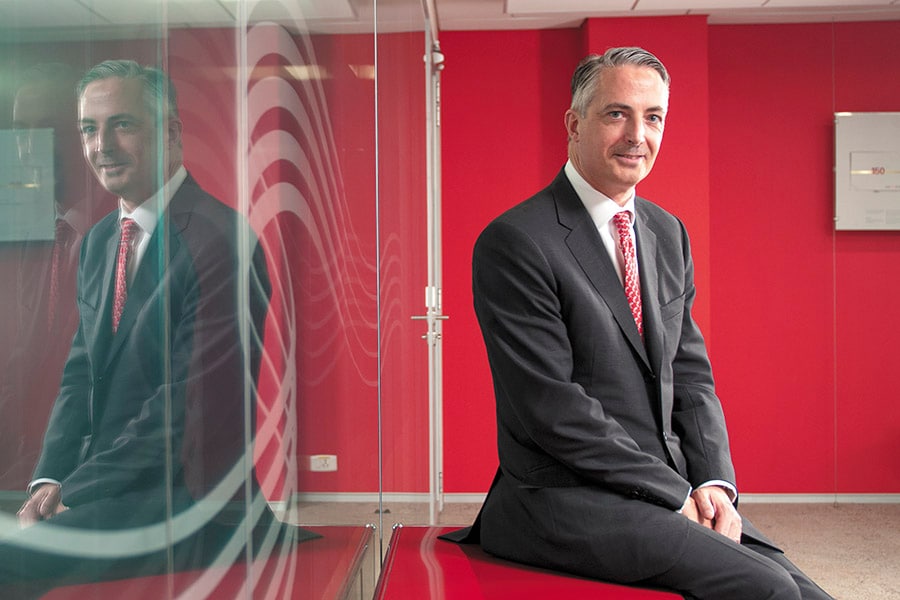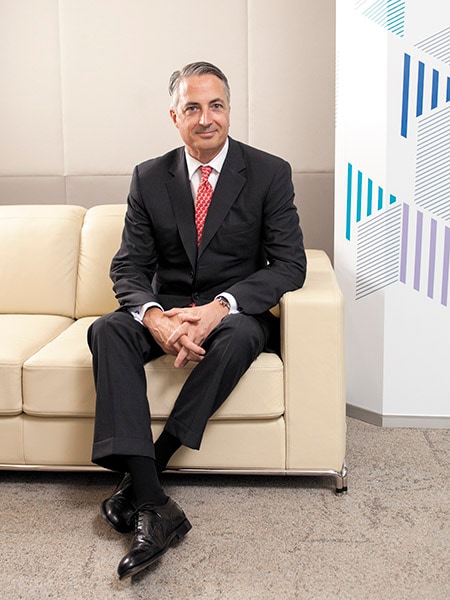
The physical branch is less relevant now: HSBC India CEO
HSBC India's Group General Manager and CEO Stuart P Milne says that even though the bank has closed down some branches, it is not downsizing. It is simply recognising the transition in customer behavior
 Image: Mexy Xavier
Image: Mexy Xavier
HSBC India’s Group General Manager and CEO, Stuart P Milne, led the bank to impressive financial earnings in 2016. HSBC India reported a profit before tax of $402 million for the first half of 2016, compared with $606 million for the whole of 2015, making India the HSBC group’s fourth most profitable country.
In an interview with Forbes India, Milne speaks about HSBC’s rationale behind the plan to reduce physical branches in India at a time when digital banking is picking up. He is optimistic on HSBC India’s growth, led by cross-border investments. The bank handled 25 percent of the inbound foreign direct investments (FDI) into India in 2016.
Milne also feels the Unified Payments Interface (UPI) will emerge as a game changer as India is not averse to adopting new technologies. Edited excerpts:
Q. Your reflection of 2016 for HSBC…
At the global level, HSBC reported a healthy capital ratio [the ratio of a bank’s capital to its risk-weighted credit exposures] of 13.9 percent for the first half of 2016, reflecting the phase of restructuring which the bank is going through. We sold our Brazil business and also changed the capital treatment of the investment in Bank of Communications (China’s fifth largest bank, where HSBC is a major investor). These two moves, taken together, make the capital ratio very solid.
Q. But the bank has continued to downsize in India. Is that due to digitisation?
We are not downsizing. We are recognising the transition in customer behaviour. They are not using branches the way they used to and are instead moving to mobile banking. Our customers, who are typically upscale, tell us that they want the bank to come to the mobile phone. This is relevant in India because this is a country which is an early technology adopter. We are in the process of closing 24 of our 50 branches. We are not asking any customer to close any account. The physical branch, for several, is much less relevant than it used to be.
Q. What will be the number of customers per branch, post restructuring?
That will not change significantly. Even if we transfer these customers to other branches, it will not make a material change to what is happening… we intend to continue to acquire customers. That does not mean opening more branches because branches are yesterday’s technology. When I first went to Hong Kong in 1983, we had over 400 branches; now we have just 100, but our business is much bigger. In the US too, with internet and mobile taking over, the number of branches has fallen. In India, we will see the same thing. But it could take a little longer here due to the poor state of financial inclusion. India will go from branch banking to mobile banking very quickly.
Q. How is your wealth management business faring in India?
We are one of the leading wealth managers in India. It forms a core part of the retail business, besides lending, credit cards and personal loans.
Q. How is the credit card business doing?
I think we have a lot of room to grow in that area. Credit cards business is a mechanism, a delivery channel, not a product. The problem one is trying to solve with a credit card is when a customer goes to pay for a high value item, like a refrigerator, perhaps he wants to pay in installments and the card is one way to achieve that. But again, I think credit cards are yesterday’s technology; what we need to do is put that same functionality onto the mobile phone. I think the Unified Payments Interface (UPI) is as revolutionary as ATMs were when they were introduced 20-25 years ago.
We are launching UPI technology this month [November] for our retail clients. As the industry matures, it will replace not just debit cards, but also credit cards. I am excited by new technologies. It pays for banks like ours, which have a strong brand name.
By investing in these technologies, we can increase our reach and create scale at a cost that is reasonable. With the old channel, it is not scalable. In emerging markets such as India, inflation in rentals is high, so typically bank margins come down as interest rates come down. And as competition increases and technology enables more competition, margins compress, but the physical branch network costs go up. You have to break that cycle.

Image: Mexy Xavier
Q. The change from the traditional branch to using technology: How does it help you in knowing your customers and improving the quality of assets?
We are not a mass-market bank, but more relationship-driven. Our model is to understand your financial needs and suggest the appropriate products to meet those objectives. In that process, we get to know the customer well. Technology is helping in the eKYC process. In terms of credit risks, our experience in India is good. Because we are small, we can grow with that kind of a strategy.
Q. How much more pain is there for banks in India, in terms of bad loans?
The Reserve Bank of India has done a good job in managing risks in the banking system. Adopting a conservative approach to managing risks is the best one.
However, the rate of NPAs [non-performing assets] in Indian banks remains stubbornly high. There is no quick fix to that. You need capital against which you can write off most bad debts. The challenge in India is that growth is funded by bank loans as against capital markets.
So that implies, if one has to grow by 10 percent, you need significant bank support, which could be 3 to 4 times GDP growth. To grow at that rate, one needs capital but at the same time, banks need to meet the highest levels of Basel III norms. Add to that, the Indian government owns significant stakes in the public sector banks and it does not have the budget to capitalise the lenders; you are in a difficult situation.
Q. So where will the capital come from?
It could come from the private sector if the government is willing to see some of its stake come down and this government may be prepared to do that under the right circumstances but there is the question of whether investors will be willing to take that risk. There is no easy answer. The banks that do not have the necessary skill sets will need to acquire them to manage risk in a better way.
Q. Has enough been done to reduce the quality of bad debts?
The fact is that there is lower credit offtake, fewer loans are being given and fewer new bad debts are being created. The management teams I speak to are aware of the problems.China went through a similar problem of NPAs and the government stepped in to help write them off and also got international expertise in risk management to help the banks.
Q. Where do you see HSBC India’s growth going forward?
It is coming from simple things—taking deposits and giving loans. We’re focusing on target customer growth and taking market share from other banks. Our deposits are 1-2 percent of the total market. Even when the industry is not growing, we have an opportunity to grow. HSBC India handled 25 percent of the inbound FDI into India in 2016. That is because we have been able to leverage on a strong business franchise in the UK, France, Germany and the US. So we are not trying to replicate the business model of a large private sector Indian bank.
Q. You spoke about gaining market share. Has it come at the cost of the spreads?
In general, spreads will always decline as interest rates decline. I don’t see interest rates in India moving up. Globally, interest rates will continue to remain low for some time. We will also have to see the impact of demonetisation on the economy.
Q. What is your observation on demonetisation?
Leaving aside the execution challenges, demonetisation is a fantastic move. Part of the government’s intention is to capture black money, but it is also aimed at widening the tax net. It is important because the government’s long-term objective is to reduce the tax rate. It can only do that if it widens the tax base. That will be a long-term positive for the economy and promote investments.
Q. So the slowing of consumption demand will be a blip?
There will be some short-term impact on consumption, which will have an impact on GDP. This is a confidence issue. There are still the same number of Rs 100 notes in the economy as there were yesterday. Yet people are lining up outside banks to get Rs 100 notes. There is no logical reason for that. We need to just get beyond that.
Q. Do you think demonetisation could have been implemented better?
I don’t want to criticise anyone… but it is a very bold move. It will benefit India in the long term. I was in Hong Kong recently and was presenting to our risk committee. I discussed that this was a positive move and the extent to which it can reduce black money will be good for the financial system.
Q. But the Rs 2,000 notes might regenerate black money at a higher pace?
Some people may say that with the Rs 2,000 note, it will become twice as easy to hide your money. If you look strategically, the emergence of the black economy took place when income tax rates in India were very high. This encouraged people to hide their income. In the current tax regime, it is a reasonable expectation from the government that everyone should pay taxes.
Q. Has digital banking picked up further post demonetisation?
Our customer base is already digitally savvy, so demonetisation is not changing it too much. But it pushes citizens to use digital channels.
The UPI technology will be a game changer. We are now offering these services to our corporate clients and plan to roll it out to retail clients in January. It will change the way individuals interact with banks, telecom and ecommerce companies.
Q. But black money is not kept only in cash. Do you expect the government to take steps to attack other forms of ill-gotten wealth?
This [demonetisation] is a battle in a long war. This initiative will help to change the culture of India. There is no one silver bullet; there are several measures. What is critical is that the government needs to preserve the goodwill of the people. I have seen the goodwill.
Q. How will Brexit impact HSBC?
The Brexit vote was a surprise for everyone. It creates an extended period of uncertainty and we will not know the full impact of it until the new agreements are put in place. There are elections in Holland, France and Germany coming up and in all these countries, the question around the future of Europe is topical. From an HSBC standpoint, we are better positioned because though we are headquartered in London, we have a large business in France and Germany. Many global corporations may think twice before making investments in London. If they want to go to Germany or France, HSBC can help them.
For HSBC India, there are opportunities. The UK government will put in place trading arrangements with key partners outside the European Union, particularly the Commonwealth countries.
(This story appears in the 30 November, -0001 issue of Forbes India. To visit our Archives, click here.)




